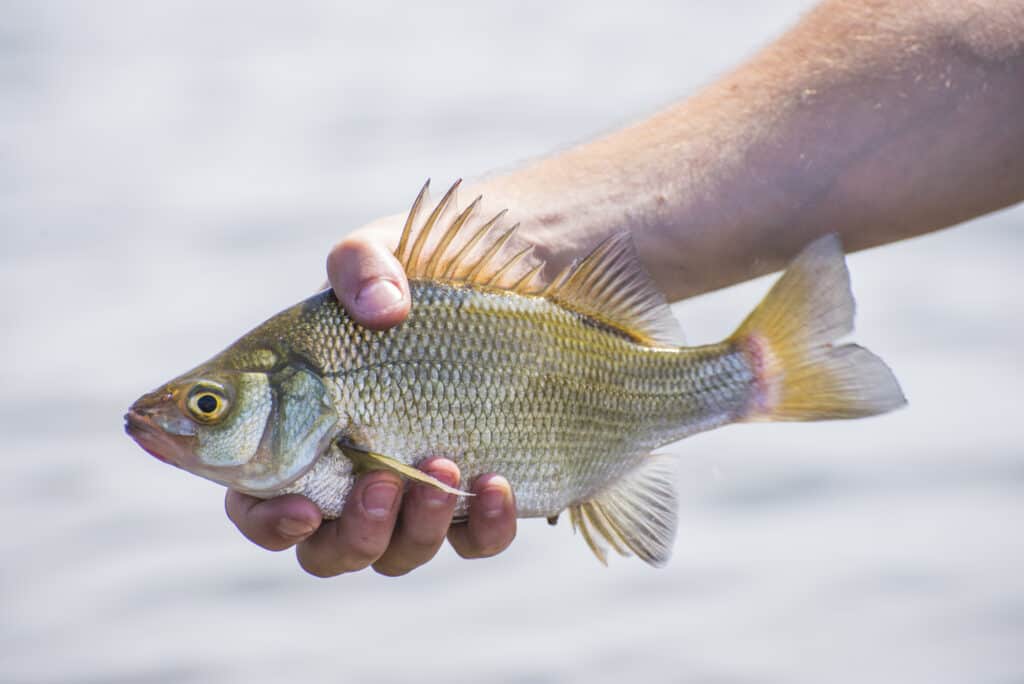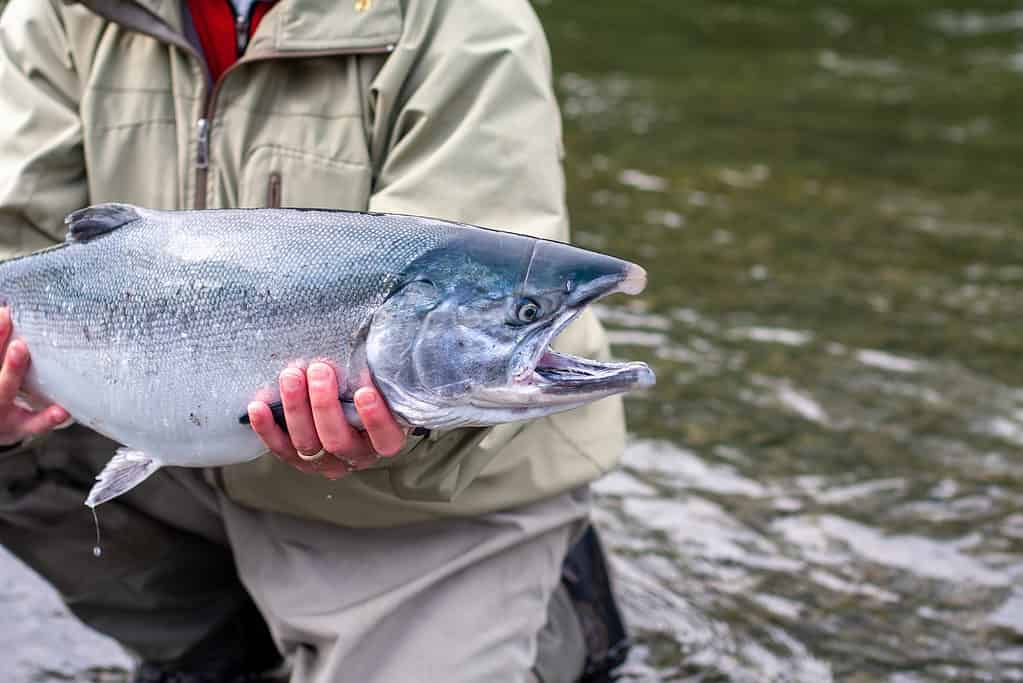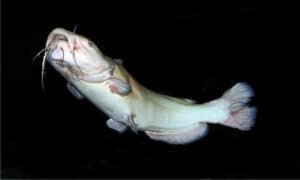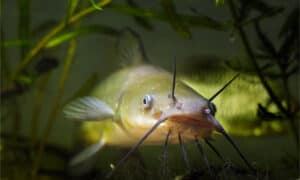Pennsylvania is an excellent state to fish for bullhead catfish. They are found throughout the state. In this article, we are going to dive into the largest bullhead catfish ever caught in Pennsylvania, fun facts about bullhead catfish, and other amazing Pennsylvania fish records.
What is the Largest Bullhead Catfish Ever Caught in Pennsylvania?
The largest bullhead catfish ever caught in Pennsylvania weighed 4 pounds and 10 ounces. Ian C. Radler caught this large bullhead in 2011 in Beltzville Lake.

The largest bullhead catfish ever caught in Pennsylvania weighed 4 pounds and 10 ounces.
©Brenda Miroslav/Shutterstock.com
About Bullhead Catfish
Bullhead catfish (Ameiurus) is a genus of catfish. There are three species, black bullhead, yellow bullhead, and brown bullhead. The biggest differences between the three are the coloration and size. Bullhead catfish are a favorite for many anglers. However, they aren’t always used as food. Sometimes, they are caught for fun or to use as bait for larger fish.
Appearance and Size
Bullhead catfish range in appearance. Black bullheads are generally black and tan. They have barbels located near its mouth and no scales. Black bullhead catfish have black barbels, which is how this species gets its name. They are the largest of all bullheads with a maximum weight of around 4 pounds. The largest recorded bullhead catfish was 24 inches long. Most bullhead catfish though only weigh 1 to 2 pounds, sometimes less.
Brown bullheads instead are brown-green and light green. They also have light creme or white bellies along with darker, brown-black speckles along the entire surface of the catfish. They also don’t have scales. Brown bullheads have an anal fin with 21 to 24 rays. They also have 8 long barbels, ranging from black to yellowish brown. Brown bullheads weigh between 1.1 and 7.9 pounds, although 7.9 pounds is very rare.
Yellow bullheads yellow-olive to slate black on the back. In some habitats, they are also mottled. Generally, yellow bullheads have lighter sides and a white underside. Their anal fin has slightly for rays than brown bullheads, 24 to 27. They are easy to identify from the white barbels under their chin absent in the other bullhead species. These medium-sized catfish are about 2 pounds.

Three species of bullhead catfish range in coloration and size.
©Mustafa Ragip/Shutterstock.com
Distribution and Habitat
Bullhead catfish are found throughout North America. You can find them from central Montana, south to Texas, and in streams of the Gulf of Mexico and Atlantic Coast. Bullhead catfish also live as north as New Brunswick and Quebec, Ontario, Manitoba, and Saskatchewan.
Bullhead catfish are bottom feeders. They live in many different habitats including brackish low-oxygen ponds, rivers, and lakes.
Diet
So, what do bullhead catfish eat? These medium-sized catfish consume plants, insects, and other small fish. However, they mainly eat young insects. Sometimes bullhead catfish eat fish eggs. The diet of a bullhead catfish though depends on the species. For instance, yellow catfish eat more plant matter than brown and black bullheads.
Predators
Bullheads have many predators. They are often consumed by large birds like blue herons. Sometimes, bullheads are also hunted by larger pike, flathead catfish, and snapping turtles. The main predator of a bullhead though is anglers.
Other Fish in Pennsylvania
Bullhead catfish are just one species of fish in Pennsylvania. There are many you can find throughout the state. Pennsylvania is home to over 2,500 lakes, many of which are perfect for boating, swimming, kayaking, and fishing. Some of the best fishing spots in Pennsylvania are Raystown Lake, Lake Erie, Allegheny Reservoir, Lake Arthur, and Blue Marsh Lake. Listed below are a few fish species you may find in these lakes!

One of the best fishing lakes in Pennsylvania is Blue Marsh Lake.
©Delmas Lehman/Shutterstock.com
Freshwater Drum
The first fish on our list is the freshwater drum. Freshwater drums are endemic to North and Central America. They are currently listed as Least Concern on the IUCN Red List. Freshwater drums are popular gamefish. They go by many names including Shepherd’s Pie, gray bass, grunter, and Gasper goo. Most freshwater drums are about 5 to 15 pounds. However, the largest recorded freshwater drum weighed a jaw-dropping 54 pounds and 8 ounces. So, how does the Pennsylvania state record compare? Tim Rogers caught a 19-pound and 14-ounce freshwater drum in the Monongahela River in 1994.

Freshwater drums are large freshwater fish listed as Least Concern on the IUCN Red List.
©Roxana Gonzalez/Shutterstock.com
Rainbow Trout
The next fish on our list is the rainbow trout. Rainbow trout are vivid fish with a very wide range. Their native range is mainly from the coastal waters and tributary streams of the Pacific basin. However, you can find these beautiful fish throughout the United States and other countries like New Zealand and Australia. Rainbow trout range in size. They can weigh as little as 1 pound and as much as 20 pounds or more. Their coloration also depends on their environment and the subspecies. Some are redder than others. These fish though are known for having a reddish pink stripe on their bodies, most noticeable during breeding.
In Pennsylvania, the largest rainbow trout ever caught weighed 15 pounds and 6 ounces. Technically, there are two Pennsylvania records. For example, Dennis L. Clouse caught the 15-pounder in Jordan Creek in 1986. The other record goes to Eli Borger. This angler caught a 13-pound and 8-ounce golden rainbow trout in the Mahoning Creek in 2008.

Rainbow trout have been widely introduced throughout the world. They are popular gamefish.
©Henrik A. Jonsson/Shutterstock.com
Bluegill
Bluegills are also commonly found in Pennsylvania. These vibrant fish are known for their blueish scales and black ‘earmark’. Bluegills are native to North America, specifically east of the Rocky Mountains. They are members of the Centrarchidae family. Bluegills are generally about 7.5 inches long, although they can reach up to about about 16 inches. They also weigh about 2.6 pounds. The largest bluegill ever caught in Pennsylvania is a little larger than average. Tom Twincheck caught the state record for 2-pound and 9-ounce bluegill in Keystone Lake in 1983.

On average, bluegills weigh 2.6 pounds and are between 4 to 12 inches long.
©Brookieland/Shutterstock.com
Walleye
Also in Pennsylvania are walleye. These lovely fish are native to most of Canada and to the Northern United States. Walleye are large olive and goldfish. Their coloration is broken up by five darker saddles that extend to the upper sides of the fish. Walleye are popular fish for anglers. Not only are they tough to catch and put up a fun fight, but they also taste delicious. Anglers have the best shot of catching walleye at night as this is when these fish are active and hunting. Live bait works best. The record for the largest walleye in Pennsylvania was recently caught. In 2021, Richard E. Nicholson caught an 18-pound and 1-ounce walleye in the Youghiogheny River.

Walleye are among the most popular game fish in North America.
©iStock.com/FedBul
Coho Salmon
Last but not least is the coho salmon. This species of salmon is native to both sides of the North Pacific Ocean. However, this species has been introduced to all the Great Lakes and some landlocked lakes in the United States. Coho salmon are silver and dark blue when in the ocean, but change drastically when entering freshwater. For instance, these fish develop a hooked jaw and teeth. Coho salmon also develop bright red-pink sides, bluish-green heads, and backs. They also develop dark bellies and dark spots on their backs. So, how big can they get? Coho salmon are generally 7 to 11 pounds but can reach as much as 36 pounds. In Pennsylvania, coho salmon are uncommon. You may still find them in Lake Erie. The best time to fish for salmon in this state is from mid-August through mid-September.

Coho salmon are uncommon in Pennsylvania.
©iStock.com/christiannafzger
The photo featured at the top of this post is © Rostislav Stefanek/Shutterstock.com
Thank you for reading! Have some feedback for us? Contact the AZ Animals editorial team.







